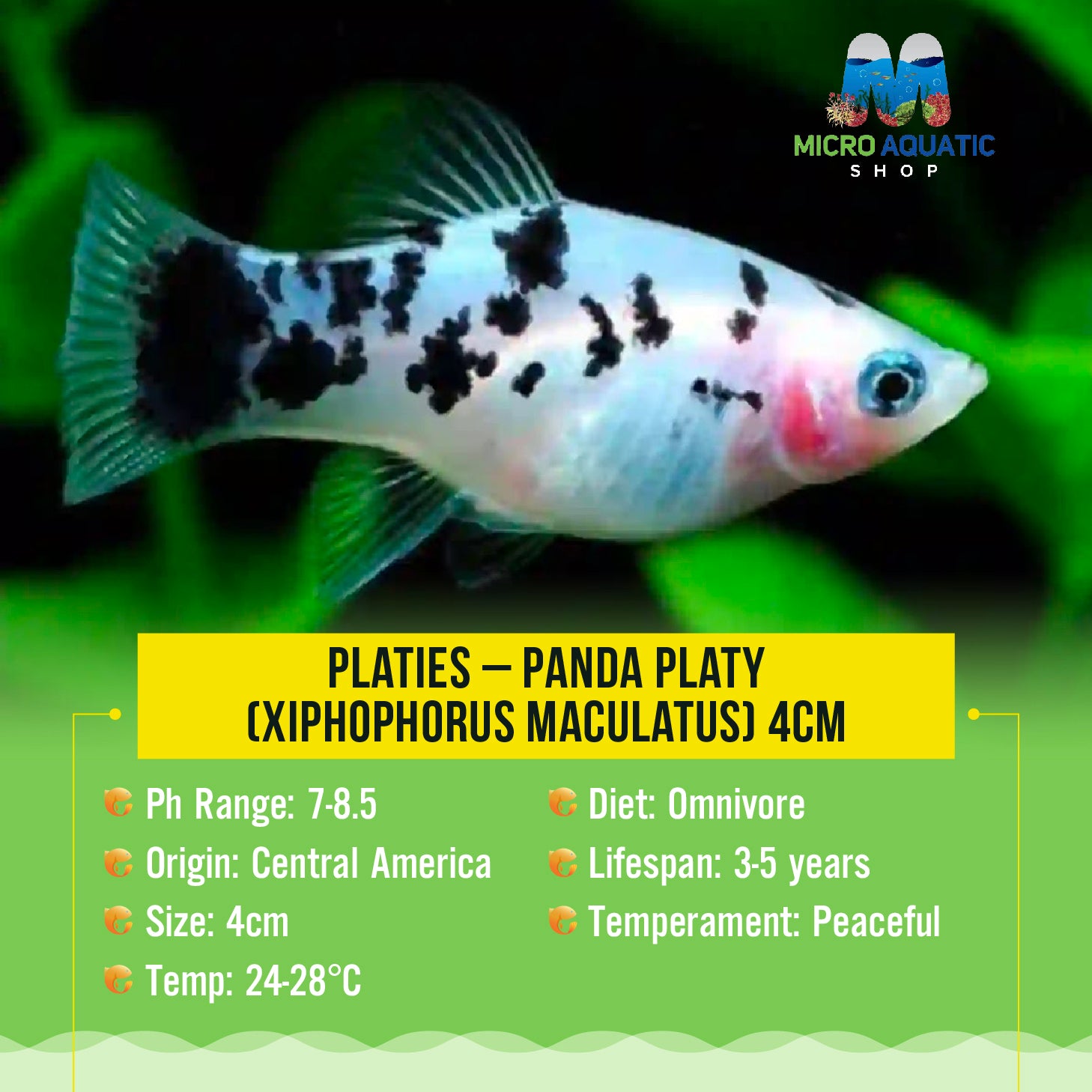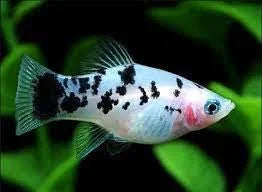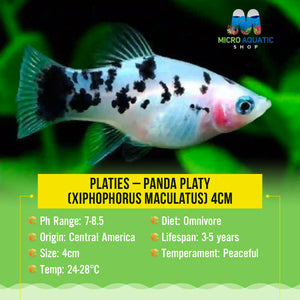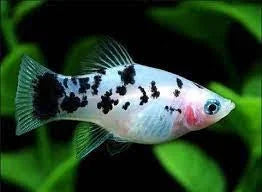Platies – Panda Platy (Xiphophorus maculatus) 3cm
Guarantee Safe Checkout
Panda Platy Fish (Xiphophorus Maculatus) - Colorful Freshwater Aquarium Fish
The panda platy, known scientifically as Xiphophorus maculatus, is a standout in freshwater aquariums. These vibrant fish have won the hearts of many in Australia. Their panda-like colour and friendly nature make them a favourite in home aquariums.
 The panda platy's appeal in aquariums comes from their beauty and easy care.We'll look into their origins, physical traits, and why they're loved by Australian hobbyists.
The panda platy's appeal in aquariums comes from their beauty and easy care.We'll look into their origins, physical traits, and why they're loved by Australian hobbyists.Key Takeaways
The panda platy, Xiphophorus maculatus, is a colourful freshwater fish that is popular in home aquariums across Australia. These fish are known for their distinctive panda-like colouration, which sets them apart from other tropical fish species. Panda platys are hardy and adaptable, making them a great choice for both novice and experienced aquarium enthusiasts. Their vibrant appearance and easy-going nature have contributed to their growing popularity in the Australian aquarium hobby. Understanding the panda platy's origins, physical characteristics, and care requirements is key to ensuring their successful acclimation and thriving in home aquariums.
Introduction to Panda Platy Fish, Xiphophorus Maculatus
We're excited to share the world of Panda Platy Fish, known as Xiphophorus Maculatus. These colourful fish are loved by many in Australia and worldwide. They're known for their bright looks and simple care.
Origin and Natural Habitat
Panda Platy Fish come from Central America's freshwater streams and rivers. Their homes stretch from Mexico to Guatemala. They live in slow, oxygen-rich waters near plants and driftwood.
Physical Characteristics
These fish are easy to spot with their black-and-white pattern, like a giant panda. They grow up to 5-6 centimetres long. Females are usually a bit bigger than males.
Popularity in Home Aquariums
The Panda Platy's striking look and calm nature make them a hit. They're great for both new and seasoned fish lovers in Australia. They get along well with many other fish, perfect for a community tank.
Setting Up the Perfect Tank Environment
Keeping freshwater pets like Panda Platy Fish right is key. We know how important a good home is for them. Here, we'll show you how to set up the best freshwater aquarium for your fish.
Tank Size and Dimensions
Panda Platy Fish love to be in groups. For a small school of 4-6 fish, a 10-gallon tank is best. But, if you want more fish, you'll need a bigger tank. Add 2-3 gallons for each extra fish.
Water Parameters
Temperature: They like warm water, between 72-82°F (22-28°C). pH: The best pH for them is 6.8-8.0. Hardness: They do well in water that's moderately hard to hard, with a GH of 8-15 dGH.
Suitable Tank Mates
Choosing the right tank mates is important. Look for peaceful fish that get along well. Good choices include guppies, mollies, and small tetras.
| Parameter | Ideal Range |
| Temperature | 72-82°F (22-28°C) |
| pH | 6.8-8.0 |
| General Hardness (GH) | 8-15 dGH |
By thinking about these things, you can create a great freshwater aquarium for your fish. A well-set-up tank is crucial for their health and happiness.
Dietary Requirements and Feeding Habits
Keeping tropical fish, like the Panda Platy (Xiphophorus maculatus), healthy is all about their diet. As aquarium lovers in Australia, we focus on giving them the right food. This is key for their well-being.
Recommended Food Types
Panda Platys eat both plants and animals. They do well on a mix of: High-quality flakes or pellets for tropical fish Small freeze-dried or frozen foods like brine shrimp and bloodworms Fresh veggies like spinach and zucchini Occasional treats like algae wafers or cooked, unseasoned seafood
Feeding Schedule
Feeding them regularly is important. We feed Panda Platys a small amount two to three times a day. This lets them eat it all in a few minutes. It keeps them healthy without making the water dirty.
Nutritional Needs
Panda Platys need a diet full of proteins, fats, carbs, vitamins, and minerals. A varied diet and regular feeding schedule help them stay colorful and healthy. This is good for their immune system and overall health in their aquarium.
| Nutrient | Importance for Panda Platys |
| Protein | Supports growth, tissue repair, and muscle development |
| Fats | Provides energy and aids in the absorption of fat-soluble vitamins |
| Carbohydrates | Supplies additional energy and supports overall health |
| Vitamins and Minerals | Essential for immune function, coloration, and various biological processes |
Breeding and Reproduction Guidelines
We love watching Panda Platy fish breed. These fish are colourful and breed a lot, making them popular. Here, we'll show you how to breed and care for these live-bearing fish.
Optimal Breeding Conditions
To breed Panda Platy fish, create a natural environment. Keep the water at 22-26°C and pH between 6.8-8.0. Add hiding spots and live plants for safety. Also, change the water a bit often and use gentle filters.
Signs of Pregnancy and Fry Care
Look for a gravid spot on the female to know she's pregnant. When her belly looks round, it's time. Keep the tank dark and add hiding spots for the fry. Feed them crushed flakes or small live foods for growth. "Breeding Panda Platy fish is a rewarding experience that allows us to witness the incredible cycle of life in our home aquariums." Follow these tips for successful breeding. Watching the fry grow is amazing. It shows the beauty of the underwater world.
Health Care and Common Issues
Keeping our panda platy fish healthy is key to being a good ichthyology and pet owner. We'll look at how to prevent diseases, treat them, and keep the water clean. This is important for these lovely freshwater fish.
Disease Prevention
To keep our panda platy fish healthy, we must prevent diseases. This means quarantining new fish, testing the water often, and watching for sickness. By being quick to spot and fix problems, we can keep our fish healthy for a long time.
Treatment Options
If our panda platy fish get sick, we need to know how to treat them. Diseases like fin rot and ich can be treated with the right medicine and water changes. It's helpful to get advice from a vet or ichthyologist to find the best treatment.
Water Quality Management
Good water quality is essential for our panda platy fish's health. We need to test the water, change it sometimes, and use good filters. By keeping the water clean, we can make a healthy home for our fish.
| Water Parameter | Ideal Range |
| pH | 6.5 - 7.5 |
| Temperature | 72°F - 82°F (22°C - 28°C) |
| Ammonia | 0 ppm |
| Nitrite | 0 ppm |
| Nitrate | Less than 20 ppm |
By focusing on preventing diseases, knowing how to treat them, and keeping the water clean, we can keep our panda platy fish happy and healthy.
Conclusion
The panda platy fish, or Xiphophorus maculatus, is a stunning addition to any freshwater aquarium. They are known for their vibrant panda-like colours and lively nature. This makes them a favourite among aquarium lovers.
 We've looked at how to set up the best tank for them and how to keep them healthy.
We've looked at how to set up the best tank for them and how to keep them healthy.FAQ
What are Panda Platy Fish?
Panda Platy Fish, also known as Xiphophorus maculatus, are a favourite in freshwater aquariums. They have a unique panda-like colour and are very peaceful. These fish are loved by many in Australia and globally.
Where do Panda Platy Fish come from?
Panda Platy Fish come from Central America, especially Mexico and Guatemala. They live in tropical freshwater areas and do well in home aquariums.
What do Panda Platy Fish look like?
Panda Platy Fish are small, growing up to 5 centimetres. They have a black body and white fins, looking like a panda. Some may have orange or yellow splashes too.
Why are Panda Platy Fish popular in home aquariums?
They are popular for being peaceful, colourful, and easy to care for. These fish are hardy and get along well with many other fish.
What size tank do Panda Platy Fish need?
A 60-litre tank is best for a group of Panda Platy Fish. It gives them room to swim and live healthily. Make sure the tank is clean, well-filtered, and has hiding spots and plants.
What do Panda Platy Fish eat?
Panda Platy Fish eat a variety of foods. Feed them high-quality flakes, pellets, and sometimes live foods like brine shrimp. Don't overfeed to keep them healthy.
Can Panda Platy Fish be bred in home aquariums?
Yes, they can be bred at home. You'll need a planted tank and slightly warmer water. Remember to separate the fry from adults to help them survive.
How do I maintain the health of Panda Platy Fish?
Keep the water clean and balanced for your fish's health. Change the water regularly and watch for diseases. A clean tank and proper diet will help them thrive.
| Quantity |
1 platy |
|---|






